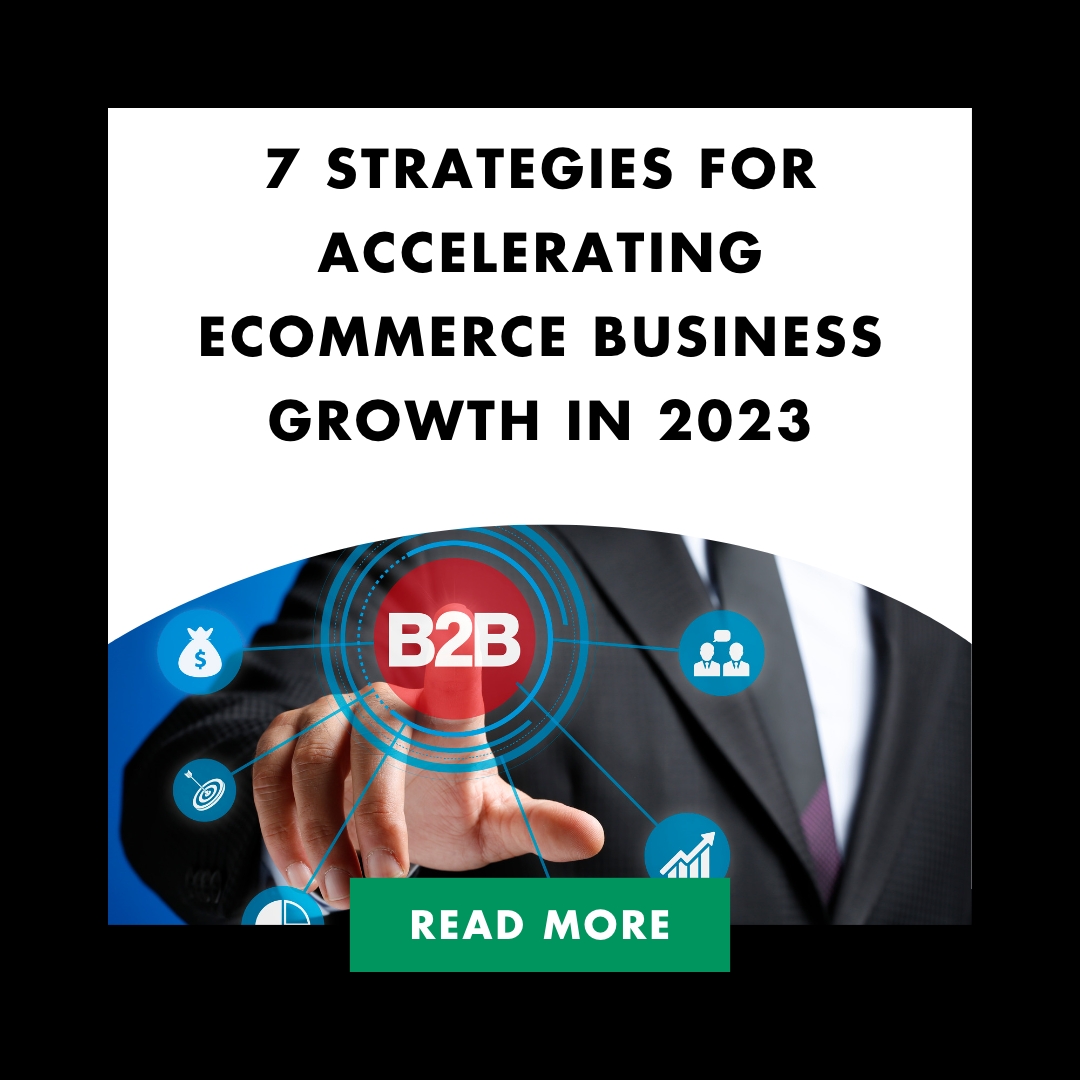7 Strategies for Accelerating eCommerce Business Growth in 2023
In the rapidly evolving world of eCommerce business growth, staying ahead of the competition requires a deep understanding of emerging trends and technologies. This blog post will provide valuable insights into key areas that can significantly impact your online store’s success and scalability.
From mobile device usage to fintech innovations, we’ll explore how technology is driving eCommerce growth while improving customer experience. We’ll also get into strategies for expanding into high-potential emerging markets and adapting to local preferences.
Diversifying your offerings plays a key influence in your eCommerce business’s growth, so we’ll discuss streamlining supply chain management processes and enhancing your fulfillment capabilities. You’ll also learn about transitioning from traditional retail outlets to digital spaces by leveraging omnichannel marketing strategies.
Lastly, we will share best practices for scaling your eCommerce business through website optimization, data analytics-driven marketing campaigns, SEO tactics, content marketing strategies, and exceptional customer service. Additionally, we’ll cover how to adapt to changing consumer behavior patterns by offering personalized shopping experiences and emphasizing convenience factors such as fast shipping.
Throughout this blog post, we will dive deeper into various aspects of Klaviyo email marketing that can help you acquire and retain subscribers effectively. We’ll explore how to design eye-catching emails using dynamic blocks and templates while crafting compelling subject lines that entice users to open your messages.
Furthermore, we’ll discuss best practices for ensuring high email deliverability rates by adhering to ESP guidelines and employing rigorous campaign testing methods. Additionally, learn about A/B testing strategies within Klaviyo along with successful brand examples that have leveraged these techniques for optimal results.
Last but not least, discover how Klaviyo’s robust analytics tools and integrations can enhance your customer experiences through omnichannel campaigns while providing valuable insights into user interactions across multiple platforms.
Table of Contents
Expanding into Emerging Markets
Identifying High-Potential Emerging Markets
The first step towards expanding your eCommerce business is identifying which emerging markets hold the most promise for growth. These nations, including India, Brazil, Indonesia and Nigeria have experienced a surge in web utilization in recent times. Additionally, these countries boast large populations with growing middle classes that are eager to embrace online shopping experiences.
Adapting Your Strategy to Cater to Local Preferences
To succeed in new markets, it’s crucial that you tailor your approach according to regional tastes and preferences. This includes offering products that resonate with local consumers while also adapting marketing strategies accordingly. For example:
- Incorporate locally popular payment methods like mobile wallets or cash-on-delivery options.
- Create culturally relevant content by collaborating with influencers from the region or translating existing materials into local languages.
- Analyze market trends specific insights about consumer behavior patterns unique to each country or region you’re targeting.
Overcoming Challenges Related to Logistics and Infrastructure
Fulfilling orders efficiently and in a timely manner is a key aspect of providing an excellent customer experience, especially when dealing with international shipments. To overcome logistical challenges associated with expanding into emerging markets:
- Partner with reliable local fulfillment providers who have established networks and knowledge in the area.
- Invest in technology that streamlines order management and tracking processes for seamless cross-border transactions.
- Consider implementing a regionalized inventory system to reduce shipping times and costs while maintaining adequate stock levels in each market.
In conclusion, by identifying high-potential emerging markets, adapting your strategy to cater to local preferences, and overcoming logistical challenges related to infrastructure, you can successfully expand your eCommerce business into new territories and reap the benefits of increased revenue and growth opportunities. As more people around the world gain access to the internet through mobile devices and advancements in fintech solutions, online shopping becomes an increasingly popular activity across the globe, making now the perfect time to invest efforts towards global expansion endeavors.
Key Takeaway:
Expanding into emerging markets is a massive opportunity for eCommerce businesses to reach untapped regions and grow globally. To succeed, it’s crucial to identify high-potential markets, adapt strategies to cater to local preferences, and overcome logistical challenges related to infrastructure by partnering with reliable local fulfillment providers and investing in technology that streamlines order management processes.
Diversification of Product Offerings
Exploring New Product Categories for Your Business
To remain relevant in today’s rapidly changing market, it is essential for online stores to explore new product categories that cater to evolving consumer demands. This may involve researching emerging trends within your target audience or identifying gaps in the current market where your business could potentially excel. For example, Shopify offers a list of niche ideas that can help you discover untapped opportunities within various industries.
Streamlining Supply Chain Management Processes
A crucial aspect of expanding into new product categories involves optimizing your supply chain management processes. This includes ensuring efficient sourcing from reliable suppliers, maintaining accurate inventory levels, implementing effective quality control measures, and utilizing advanced technologies like BigCommerce’s integrated SCM tools. Streamlined supply chains not only reduce operational costs but also contribute significantly towards delivering an exceptional customer experience by minimizing delays or stockouts.
- Sourcing: Partner with reputable suppliers who share similar values regarding sustainability and ethical practices.
- Inventory Management: Implement real-time tracking systems that provide insights into available stock levels across multiple channels (online store & brick-and-mortar locations).
- Quality Control: Establish strict guidelines for product inspections to ensure consistency and maintain customer trust.
Enhancing Fulfillment Capabilities for Better Customer Experience
The final step in diversifying your eCommerce business’s product offerings is enhancing fulfillment capabilities. This involves optimizing order processing, packaging, shipping, and returns management processes to meet or exceed customer expectations. By investing in advanced fulfillment solutions like ShipStation’s comprehensive platform, you can automate various aspects of the process while offering customers flexible delivery options such as same-day shipping or curbside pickup at brick-and-mortar stores.
Incorporating optimal practices into your eCommerce approach can open up new opportunities and lead to sustainable success by creating a devoted customer base that values the comfort and individualization provided through an assorted selection of items.
Key Takeaway:
To achieve long-term growth in eCommerce, businesses must diversify their product offerings by exploring new categories and optimizing supply chain management processes. This involves partnering with reputable suppliers, implementing real-time inventory tracking systems, establishing strict quality control guidelines, and enhancing fulfillment capabilities through advanced solutions like ShipStation. By embracing these changes and delivering exceptional customer experiences, online stores can stay competitive in today’s rapidly evolving market.
Transition from Traditional Retail Outlets to Digital Spaces
Strategies for Transitioning from Brick-and-Mortar Locations
If you wanna take your shop from a physical store to the online world, you gotta start with a strong base. That means picking the right eCommerce platform. Shopify and BigCommerce are great options ’cause they’re super easy to use, even if you’re not a tech whiz. Once you’re set up, don’t forget to jazz up your product listings. Put in killer descriptions and snazzy pics. It’ll catch people’s eye and help you climb up those search engine rankings.
- Selecting the appropriate eCommerce platform for your business needs
- Crafting compelling product listings with accurate descriptions and images
- Optimizing website design and navigation for a seamless user experience
Reducing Operational Expenses by Going Virtual
Moving away from physical storefronts allows businesses to significantly reduce overhead costs such as rent, utilities, and staffing expenses. By investing in an effective eCommerce strategy instead, companies can allocate resources more efficiently toward marketing efforts or inventory expansion. Furthermore, embracing digital technology enables businesses to collect valuable customer data which can be used for targeted marketing campaigns or personalized shopping experiences.
- Saving on rent and utility costs associated with maintaining a physical location
- Focusing resources on expanding inventory or improving marketing strategies
- Leveraging customer data collected through online interactions
Leveraging Omnichannel Marketing Strategies
Transitioning to a digital space does not mean abandoning traditional marketing channels altogether. Businesses should utilize an omnichannel strategy, ensuring customers have a uniform experience across all digital and physical touchpoints. This can include maintaining a social media presence, offering in-store pickup options for online orders, or even hosting pop-up events at physical locations.
- Integrating multiple channels to create a cohesive customer journey
- Maintaining a strong brand identity across all platforms
- Incorporating brick-and-mortar elements into the eCommerce strategy when appropriate
By embracing the transition from traditional retail outlets to digital spaces, eCommerce businesses can capitalize on evolving consumer preferences while reducing operational expenses. Implementing effective strategies such as choosing the right platform, optimizing product listings, and adopting an omnichannel approach will help ensure success in today’s competitive market landscape.
Key Takeaway:
Ecommerce businesses can grow by transitioning from traditional retail outlets to digital spaces, reducing operational expenses and leveraging omnichannel marketing strategies. To do so successfully, they should choose the right eCommerce platform, create high-quality product listings with accurate descriptions and images, optimize website design for a seamless user experience, and maintain a strong brand identity across all platforms.
Best Practices for Scaling Your eCommerce Business
Optimizing Website Design and User Experience
- Ensure it’s mobile-friendly as more people are shopping from their smartphones.
- Provide intuitive menus to facilitate rapid product discovery.
- Incorporate high-quality images and product descriptions that accurately represent the items being sold.
Utilizing Data Analytics for Targeted Marketing Campaigns
By leveraging data analytics, businesses can tailor their marketing campaigns to specific customer segments based on their preferences or behaviors. Some popular tools include Google Analytics and Facebook Pixel which enable businesses to track user interactions with their websites or ads respectively. You may also consider using email marketing platforms like Mailchimp or Klaviyo that offer built-in analytics features.
Investing in SEO and Content Marketing Strategies
- Create informative blog posts related to topics within your industry;
- Share content on social media platforms to engage with your audience;
- Collaborate with influencers or other businesses within your niche for guest posting opportunities.
Prioritizing Exceptional Customer Service
- Offer multiple channels of communication such as live chat, email support, and phone lines.
- Provide fast response times to customer inquiries and concerns.
- Create a comprehensive FAQ section on your website that addresses common questions or issues customers may encounter during their shopping journey (source).
By implementing these best practices into your eCommerce business strategy, you can effectively scale up while maintaining high levels of customer satisfaction.
Key Takeaway:
To ensure sustainable growth for your eCommerce business, adopt best practices such as optimizing website design and user experience, utilizing data analytics for targeted marketing campaigns, investing in SEO and content marketing strategies, and prioritizing exceptional customer service. By focusing on these key areas you can set your online store up for long-term success while maintaining high levels of customer satisfaction.
Adapting to Changing Consumer Behavior Patterns
In this section, we will discuss how analyzing consumer trends within your target market, offering personalized shopping experiences through technology, and emphasizing convenience factors such as fast shipping can contribute to the growth of your eCommerce business.
Analyzing Consumer Trends Within Your Target Market
To adapt effectively to evolving customer preferences, it is essential for eCommerce businesses to analyze their target market’s behavior patterns. This includes monitoring social media conversations, conducting surveys and polls on your website or email campaigns, and utilizing tools like Google Analytics for tracking user interactions with your site. By staying informed about emerging trends and adjusting marketing strategies accordingly, you can ensure that your offerings remain relevant while attracting new customers.
Offering Personalized Shopping Experiences Through Technology
Personalization has become a key differentiator in today’s competitive online marketplace, with customers expecting tailored recommendations based on their browsing history and previous purchases. To meet these expectations, consider integrating artificial intelligence (AI) algorithms into your platform that analyze user data for generating customized product suggestions. Additionally, implementing chatbots powered by natural language processing can provide instant assistance to shoppers, further enhancing their overall experience.
Emphasizing Convenience Factors such as Fast Shipping
In this era of rapid delivery services such as Amazon Prime and same-day shipping, shoppers anticipate quick arrival times when ordering online. To stay competitive in this fast-paced environment, eCommerce businesses must prioritize efficient fulfillment processes that minimize delays between order placement and delivery. This may involve partnering with reliable third-party logistics providers or investing in warehouse automation technologies for streamlining operations. Moreover, offering flexible return policies and multiple payment methods can also contribute to a seamless customer experience.
By adapting your eCommerce business strategy according to changing consumer behavior patterns, you not only cater to current market demands but also prepare for future shifts in preferences. Staying informed about emerging trends within your target audience will enable you to make data-driven decisions that enhance user experiences while driving growth for your online store.
Key Takeaway:
To achieve growth in eCommerce business, it is important to adapt to changing consumer behavior patterns. This can be done by analyzing consumer trends within your target market, offering personalized shopping experiences through technology and emphasizing convenience factors such as fast shipping. By staying informed about emerging trends and adjusting marketing strategies accordingly, you can ensure that your offerings remain relevant while attracting new customers.
FAQs in Relation to Ecommerce Business Growth
eCommerce, globally, experienced significant growth in recent years, with a compound annual growth rate (CAGR) of 14.7%. This increase can be attributed to (excluding the Pandemic) advancements in technology, increased internet penetration, and changing consumer behavior patterns. Statista predicts that worldwide eCommerce sales will reach $6.54 trillion in 2023.
eCommerce plays a crucial role in business growth as it allows companies to expand their customer base, reduce operational costs, and offer personalized shopping experiences. By leveraging digital channels and embracing new technologies like mobile commerce and data analytics, businesses can tap into emerging markets while enhancing customer satisfaction levels through seamless online transactions and fast shipping options. Forbes highlights how AI integration can further improve the customer experience.
Mobile commerce (mCommerce) represents one of the most significant areas of eCommerce growth today due to increasing smartphone usage worldwide. According to an Insider Intelligence report, mCommerce accounted for nearly half of all US retail eCommerce sales in 2023 at around $284 billion – a figure expected to surpass $488 billion by 2024.
The future of eCommerce growth lies in continued technological advancements, such as AI-driven personalization, augmented reality (AR) for product visualization, and voice-assisted shopping. Additionally, businesses will need to adapt to changing consumer behavior patterns and focus on offering seamless omnichannel experiences. McKinsey & Company provides insights into how US shopping behavior is evolving.
Conclusion
In conclusion, eCommerce business growth can be achieved through various strategies such as leveraging technology for accessibility and secure payment processing, expanding into emerging markets while adapting to local preferences and overcoming logistics challenges, diversifying product offerings with streamlined supply chain management processes, transitioning from traditional retail outlets to digital spaces with omnichannel marketing strategies, and implementing best practices for scaling your eCommerce business such as optimizing website design and user experience while investing in SEO and content marketing strategies. Adapting to changing consumer behavior patterns by analyzing trends within your target market while offering personalized shopping experiences through technology is also crucial.
At Forest City Digital, we specialize in helping businesses achieve their goals of eCommerce business growth through our expertise in web development and digital marketing services, including SEO and content marketing strategy implementation. Contact us today at Forest City Digital to learn more about how we can help you scale your eCommerce business!
Klaviyo’s popular automations and integrations provide options for post-purchase upsells, win-back campaigns, and omnichannel strategies. Additionally, the rise of SMS marketing in eCommerce presents an opportunity to incorporate this capability into your overall strategy.
To take advantage of all that Klaviyo has to offer for your email marketing needs, schedule a call with Forest City Digital today.
Want to Talk Strategy?
Is this something you're looking to dive deeper into? Sign up for a free strategy session with our team!
Let's TalkSubscribe for New Content
Share on Social
New Posts to Check Out

How to Get Verified for Google Local Service Ads: A Complete Guide

Revamping E-Commerce: AI Trends and Innovations in Design

How Do I Make An Ad For Local Search Google: A Practical Guide

How To Set Up Local Search Ads On Google: 2024 Guide
What is an LSA ad? Boost Your Local Service Visibility

How Do Meta Ads Work? The Ultimate Guide To Facebook Ads in 2024

The Ultimate Guide: How to Create an Ad Account in Meta Business Suite (Step-by-Step)

What are Meta Ads? – The Ultimate Guide To Meta Advertising

Unlock your Staffing Firm’s Potential with Marketing Automation

